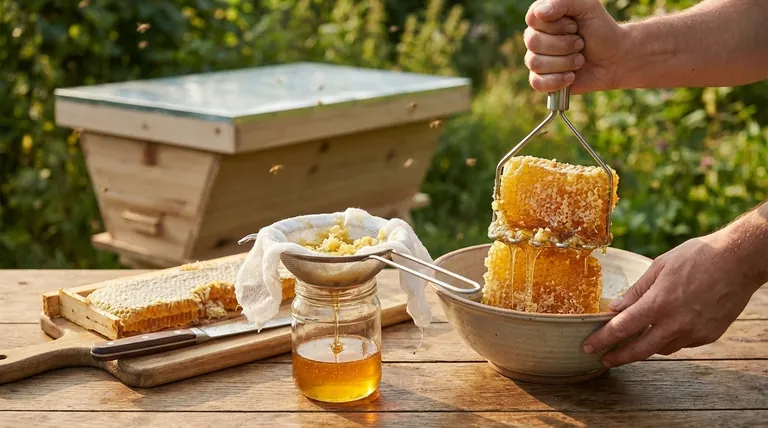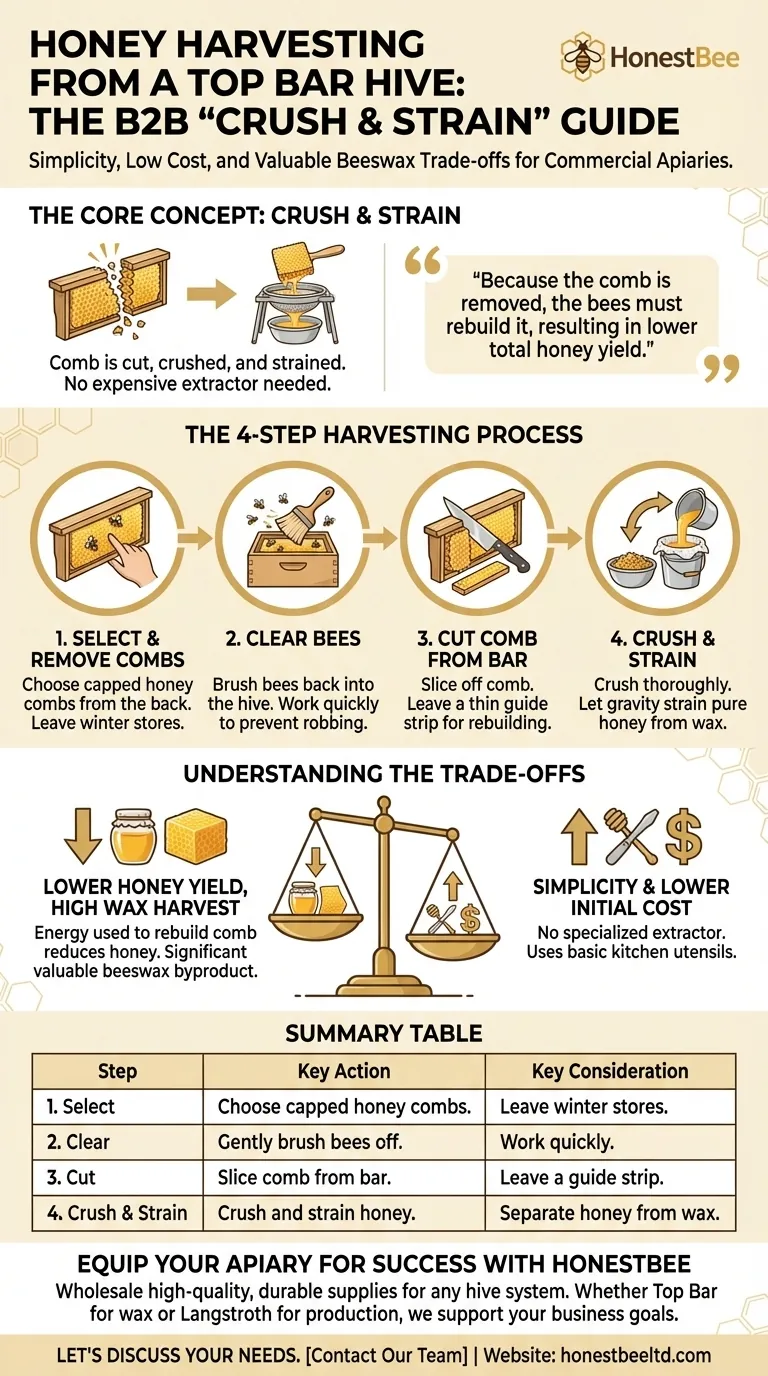In short, harvesting honey from a top bar hive requires only basic kitchen utensils. The process involves cutting the comb from the top bar, crushing it, and straining the honey through a filter to separate it from the beeswax. No expensive, specialized honey extractor is needed.
The core of top bar hive harvesting is the "crush and strain" method. This technique is defined by its simplicity and low cost, but it comes with a critical trade-off: because the comb is removed permanently, the bees must rebuild it, which results in a lower total honey yield compared to methods that preserve the comb.

The "Crush and Strain" Method Explained
The process is intuitive and can be broken down into a few simple stages. The key is to work cleanly and efficiently to minimize stress on the bees and protect your harvest.
Step 1: Selecting and Removing the Combs
Your first step is to identify which combs to harvest. You should only take surplus honey, leaving plenty for the bees to survive the winter.
The ideal combs for harvest are typically at the very back of the hive, furthest from the entrance. These are less likely to contain brood (bee larvae) and will be filled exclusively with capped honey.
Gently remove the chosen top bar from the hive.
Step 2: Clearing the Bees from the Comb
The quickest and most common method is to simply brush the bees off the comb. Use a soft bee brush to gently sweep them back down into the hive body.
Work quickly but calmly. Once the comb is clear of bees, place it into a sealed, food-grade container to prevent robbing from other bees.
Step 3: Cutting the Comb from the Bar
Move your sealed container of combs indoors or to a bee-proof area. Using a simple kitchen knife, carefully slice the honeycomb from the top bar.
It is a common practice to leave a thin, half-inch strip of the original comb attached to the top bar. This acts as a natural guide for the bees to build their new comb straight.
Step 4: Crushing and Straining
Place the cut comb into a large bowl or a food-grade bucket. Use a potato masher or your clean hands to crush the comb thoroughly, breaking open all the wax cells.
Next, set up a simple straining system. You can stretch cheesecloth over a clean bucket or use a purpose-built double-bucket strainer. Pour the crushed honey-and-wax mixture into the strainer and let gravity do the work. The pure honey will slowly drip through, leaving the beeswax behind.
Understanding the Trade-offs
The simplicity of top bar harvesting is its main appeal, but it's crucial to understand the implications of the crush and strain method, especially when compared to extractor-based hives like the Langstroth.
The Impact on Your Bees and Honey Yield
In a top bar hive, the entire comb is harvested and is not returned to the bees. The colony must expend significant energy and resources to build new wax comb from scratch.
This rebuilding effort diverts energy that would otherwise be used for foraging and producing honey. As a result, top bar hives generally produce less surplus honey than Langstroth hives, where empty combs are returned after extraction.
The Benefit: A Valuable Beeswax Harvest
The primary trade-off for a lower honey yield is a significant harvest of high-quality beeswax. Because the comb is removed, you are left with pure, clean wax after straining your honey.
This wax is a valuable resource in its own right and can be used for making candles, balms, wood polish, and other products.
Simplicity and Lower Initial Cost
Perhaps the biggest advantage is the lack of specialized equipment. The crush and strain method relies on tools most people already own.
This stands in stark contrast to Langstroth hives, which typically require a large, expensive, and difficult-to-clean machine called a honey extractor to spin honey out of the frames without destroying the comb.
Making the Right Choice for Your Goal
Your harvesting method should align with your beekeeping philosophy and objectives.
- If your primary focus is simplicity and low-cost beekeeping: The top bar hive's crush and strain method is ideal, as it avoids complex machinery and keeps startup costs minimal.
- If your primary focus is maximizing honey production: A Langstroth hive with an extractor may be a better fit, as returning drawn comb to the hive significantly boosts honey output.
- If your primary focus is harvesting both honey and high-quality beeswax: The top bar hive excels, as the crush and strain method naturally yields a substantial amount of wax as a byproduct.
Ultimately, understanding this fundamental trade-off between comb preservation and simplicity empowers you to choose the beekeeping style that best aligns with your goals.
Summary Table:
| Step | Key Action | Key Consideration |
|---|---|---|
| 1. Select Combs | Choose capped honey combs from the back of the hive. | Leave enough honey for the bees to survive winter. |
| 2. Clear Bees | Gently brush bees off the comb into the hive. | Work quickly to minimize stress and prevent robbing. |
| 3. Cut Comb | Slice the honeycomb from the top bar with a knife. | Leave a thin strip of comb as a guide for bees to rebuild. |
| 4. Crush & Strain | Crush the comb and strain honey through cheesecloth. | Gravity separates pure honey from valuable beeswax. |
Ready to equip your apiary for a successful harvest?
At HONESTBEE, we supply commercial apiaries and beekeeping equipment distributors with the high-quality, durable supplies needed for any hive system. Whether you manage top bar hives for their simplicity and beeswax yield or Langstroth hives for maximum honey production, our wholesale-focused operations ensure you get the reliable equipment your business depends on.
Let's discuss your specific needs. Contact our team today to learn how we can support your beekeeping success.
Visual Guide

Related Products
- Top Bar Beehive for Beekeeping Wholesales Kenya Top Bar Hive
- Long Langstroth Style Horizontal Top Bar Hive for Wholesale
- HONESTBEE Professional Multi-Functional Hive Tool with Ergonomic Wood Handle
- HONESTBEE Professional Long Handled Hive Tool with Precision Cutting Blade
- HONESTBEE Advanced Ergonomic Stainless Steel Hive Tool for Beekeeping
People Also Ask
- What are the labor requirements for a KTBH vs. Langstroth hive? A Guide for Apiary Efficiency
- What are the benefits of a top bar hive? A Natural, Low-Impact Approach to Beekeeping
- Why are hive inspections easier with Top Bar Hives? Achieve a Calmer, Safer Approach to Beekeeping
- What are the key features of the Kenyan Top Bar Hive? A Guide to Simpler, Natural Beekeeping
- How should a beekeeper prepare a top-bar hive for overwintering? A Guide to Ensure Colony Survival



















